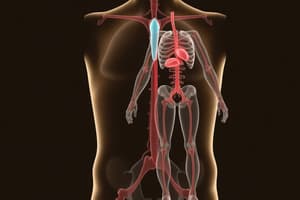Podcast
Questions and Answers
What primarily characterizes human growth from infancy to adulthood?
What primarily characterizes human growth from infancy to adulthood?
- The linear development of tissues.
- The disorganized addition of new tissues.
- The decrease in size of soft tissues.
- The organized addition of new tissue. (correct)
What is hypertrophy in the context of human growth?
What is hypertrophy in the context of human growth?
- Increase in the size of a tissue due to extracellular matrix.
- Increase in cell size. (correct)
- Decrease in tissue size due to factors like stress.
- Increase in cell number.
What factor is NOT mentioned as influencing human growth?
What factor is NOT mentioned as influencing human growth?
- Genetics
- Physical exercise (correct)
- Adequate diet
- Chronic disease
At what point does growth in humans generally complete?
At what point does growth in humans generally complete?
What describes allometric growth in humans?
What describes allometric growth in humans?
Which of the following contributes to bone elongation during growth?
Which of the following contributes to bone elongation during growth?
Which is a true statement about the growth patterns in humans?
Which is a true statement about the growth patterns in humans?
What role does the extracellular matrix play in human growth?
What role does the extracellular matrix play in human growth?
What occurs during cartilage expansion in bone elongation?
What occurs during cartilage expansion in bone elongation?
What happens to epiphyseal cartilage when long bone growth stops?
What happens to epiphyseal cartilage when long bone growth stops?
At what age range does the epiphyseal plate typically close?
At what age range does the epiphyseal plate typically close?
How long is the half-life of Growth Hormone (GH)?
How long is the half-life of Growth Hormone (GH)?
What stimulates the release of Growth Hormone (GH) through the IP3 pathway?
What stimulates the release of Growth Hormone (GH) through the IP3 pathway?
Which of the following statements about chondrocytes and hypertrophy is true?
Which of the following statements about chondrocytes and hypertrophy is true?
What pattern describes the secretion of Growth Hormone (GH)?
What pattern describes the secretion of Growth Hormone (GH)?
What effect does growth hormone secretion have during puberty?
What effect does growth hormone secretion have during puberty?
What is the primary effect of osteoblasts in bone formation?
What is the primary effect of osteoblasts in bone formation?
What characteristic defines the greatest secretion of Growth Hormone (GH)?
What characteristic defines the greatest secretion of Growth Hormone (GH)?
Which of the following statements is true regarding growth hormone secretagogues (GHS)?
Which of the following statements is true regarding growth hormone secretagogues (GHS)?
Flashcards
Hypertrophy and Calcification
Hypertrophy and Calcification
A process where chondrocytes in cartilage increase in size and the matrix surrounding them hardens with calcium deposits.
Ossification
Ossification
The process where osteoblasts (bone-building cells) replace the calcified cartilage in growing bones.
Epiphyseal Plate
Epiphyseal Plate
The area of cartilage between the epiphysis (end) and diaphysis (shaft) of a long bone where growth occurs.
Epiphyseal Line
Epiphyseal Line
Signup and view all the flashcards
Growth Hormone (GH)
Growth Hormone (GH)
Signup and view all the flashcards
GH Secretion
GH Secretion
Signup and view all the flashcards
GH Control Pathway
GH Control Pathway
Signup and view all the flashcards
Ghrelin
Ghrelin
Signup and view all the flashcards
Ghrelin and GH Release
Ghrelin and GH Release
Signup and view all the flashcards
Actions of Ghrelin
Actions of Ghrelin
Signup and view all the flashcards
What is Human Growth?
What is Human Growth?
Signup and view all the flashcards
Hypertrophy
Hypertrophy
Signup and view all the flashcards
Hyperplasia
Hyperplasia
Signup and view all the flashcards
Growth and Extracellular Matrix
Growth and Extracellular Matrix
Signup and view all the flashcards
Is Human Growth Linear?
Is Human Growth Linear?
Signup and view all the flashcards
Major Factors Influencing Growth
Major Factors Influencing Growth
Signup and view all the flashcards
Allometric Growth
Allometric Growth
Signup and view all the flashcards
What is the Zone of Proliferation?
What is the Zone of Proliferation?
Signup and view all the flashcards
How Does Cartilage Expansion Lead to Bone Elongation?
How Does Cartilage Expansion Lead to Bone Elongation?
Signup and view all the flashcards
What Structures Make Up Long Bones?
What Structures Make Up Long Bones?
Signup and view all the flashcards
Study Notes
Human Growth - Role of Endocrine System
- Human growth is the organized addition of new tissue, occurring from infancy to adulthood. It includes lengthening of the skeleton (especially long bones and spine) and increasing size of soft tissues.
- The process starts at conception and finishes in adolescence with growth plate fusion.
- Growth is an increase in the size of a tissue or organism due to hypertrophy (increased cell size) and hyperplasia (increased cell number). It also involves increased extracellular matrix around cells.
Control of Growth
- Human growth is not linear, with different growth patterns evident in neonates, infants, and during puberty.
- Major factors influencing growth include genetics, adequate diet, and the absence of chronic illness or stressful environments. While hormones play a role in growth, other factors are influential.
Allometric Growth in Humans
- Allometric growth is differential growth of body parts.
- Body proportions change between infancy and adulthood.
Growth Patterns Over Time
- A graph shows relative growth patterns of lymphoid tissue, head size, and reproductive organs over time from birth. The relative growth of a human as a whole is also shown.
Structure of Long Bones
- Long bones consist of spongy bone, medullary cavity, compact bone, epiphysis, metaphysis, and diaphysis (shaft).
Bone Elongation and Cartilage Expansion
- Bone elongation is driven by chondrocyte proliferation and cartilage expansion, pushing older cartilage towards the diaphysis.
- Chondrocytes enlarge, and the matrix calcifies.
- Osteoblasts then invade and replace the calcified cartilage with bone.
Epiphyseal Lines
- Long bone growth stops between ages 18-25.
- The epiphyseal plate closes, marking the end of bone lengthening at that point. This is visible on X-rays as an epiphyseal line.
Growth Hormone (GH)
- GH is a protein hormone, species-specific.
- Its half-life is 19 minutes.
- It's secreted in a pulsatile fashion by somatotrophs (in larger quantities than other pituitary hormones).
- Secretion is greatest in newborns, decreases by 4 years, then bursts again during puberty.
Pulsatile Secretion of GH
- GH secretion is not constant but happens in pulses.
- Patterns can change with sleep and periods of strenuous exercise.
Pathway of GH Control
- GH release is regulated by a complex pathway involving the hypothalamus, anterior pituitary, liver, and other factors.
- Factors include short-loop and long-loop feedback, as well as ultra-short-loop feedback loops. Other factors also play a role in the pathway.
Factors Influencing GH Release
- Various hormones, including ghrelin, thyroid hormones, glucocorticoids, sex steroids, and others influence GH release positively or negatively.
- Free fatty acids, glucose and other factors also influence GH release.
Ghrelin and GH
- Endorphin-derived peptides were shown to stimulate GH release.
- Growth hormone secretagogues (GHS) stimulate GH release through the IP3 pathway.
- GH receptor was cloned in 1996 and the natural ligand was identified in 1999 as ghrelin.
Actions of Ghrelin
- Ghrelin influences appetite, food intake, gastric motility, acid secretion, and reproductive function, as well as glucose and lipid metabolism. It also has cardio-vascular effects, influences endocrine effects on exocrine pancreatic secretion and bone, and modulates cell proliferation.
Studying That Suits You
Use AI to generate personalized quizzes and flashcards to suit your learning preferences.




